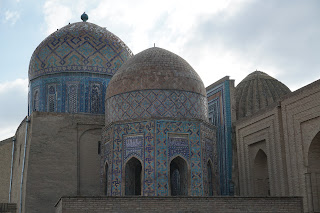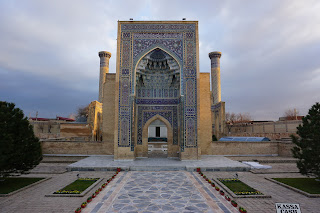My
train from Bukhara to Samarkand was modern and clean, and departed on
time. An hour and a half later, we arrived on time in Samarkand,
Uzbekistan. Since my arrival time was so early, and Samarkand was
another city with an out of the way train station, my accomodation
sent someone to pick me up from the train station.
Since
my arrival was so early, and I already knew my departure would be
early as well, I'd arranged with my accomodation to have breakfast my
first and second mornings, and not the last morning. Breakfast was
quite a spread, a buffet version of the meal I'd been served in
Khiva.
Despite
this being a proper hotel I realized that the wifi wasn't very good.
It was basically the same as I'd experienced in both Khiva and
Bukhara.
In other words, wifi in Uzbekistan is not great as a whole.
Samarkand
is an old city, a really old city. Historians have noted it was
conquered by Alexander the Great in 329 B.C. During the heyday of the
Silk Road trading route (that ran from the Mediterranean to China,)
Samarkand was one of the more important cities. It was also a center
of Islamic scholarship and theology, and those remains are what
people remember most of Samarkand.
I
started my sightseeing with a statue of Amir Timur, a conqueror from
centuries ago. The statue is in the middle of a traffic circle, and
is big. From there I kept walking along the street that takes
visitors right next to the most memorble sights of the city. I walked
right past the Registan, knowing I would be back later to explore
more. I did pause for a moment at the viewing platform. The Registan
has several huge buildings around an open square.
As impressive as
they are now, I can only begin to imagine what people back in the day
thought as they moved around the city.
I
turned onto a pedestrian road, which took me to my next sight. I
stopped briefly in the Jewish Cemetery. The community is no longer as
big as it once was, but the cemetery is worth seeing.
Further
along this road was the mausoleum of Islam Karimov, the first
president of the modern country of Uzbekistan. It looks far more
modern than other mausoleums, but the style is similar to others of
the city.
I
walked all the way to an old observatory. It was originally built by
Ulugbek, in the 15th century. At the time it was
considered one of the best observatories of the Islamic world. Modern
visitors find it unique because most of the mechanics are
underground. Granted, there aren't many remains of the observatory,
and if you're somewhat scientifcally challenged like I am, it wasn't
completely clear how the whole thing worked. Oh well. There was a
small museum in the area, describing the guy who built it, and his
interest in science in general.
The
museum also sold postcards, of course I bought plenty. (Far too many,
as it turned out.)
From
the observatory, I walked around a long way to the entrance of a
place called Shah-i-Zinda. It's a grouping of mausoleums, from as
early as the 9th century. There is an entrance fee, of
course.
The
entire area of Shah-i-Zinda is stunning. The direction of the sun
makes a big difference in how it comes out in photographs. In front
of each building is a sign that says who is buried there, as well as
architectural things to notice of that particular mausoleum.
The
names didn't mean anything to me, and I only paid attention to the
architectural notes in terms of appreciating the art of each
building.
There
is a LOT of blue tiling, in various shades. In each of the buildings
you can see the tombs, or at least the covers of the tombs. The
interiors were completely covered in tiling, in intricate designs. I
could've wandered for hours, even though the area isn't huge.
I
continued my walk by circling back around to the mausoleum of Islam
Karimov. While I was there I realized prayers were being sung for him
constantly, the melody was somewhat haunting. The actual tomb of the
man is quite small.
A
long city block away, I walked through the city market, a large area.
Like other city markets I've seen, vendors were grouped by type.
There was an area for produce, dairy, bread, etc...
I
walked back in the direction of the Registan, again passing it by. I
kept going and got to my last sight for the day: the mausoleum of
Amir Timur. While I was exploring Uzbekistan, and reading
information, I found several spellings for his name, so I'm not quite
sure in what I've written.
As
I think I've written previously, Amir Timur was the leader of an
empire. He was born in the 14th century, and eventually
was the leader of military campaigns across a wide swath of what is
now Central Asia.
The
name of the mausoleum is Gur Emir, (wikipedia tells me it is Persian
for Tomb of the King,) it's big, and stunning. As I'd already seen
around the country, there was a heap of blue tiling in various
shades, in various designs.
I
paid my entrance fee (sigh) at the gate, then walked in. There is a
garden area in the inner courtyard, from which you can appreciate the
front facade of the mausoleum building.
I
entered the main building, and was stunned. The entire room is
decorated in shades of gold. There is a chandelier, which lights up
the gold, making it even more memorable. Whoa. It's not a big room,
but the way it is decorated makes it clear someone really important
is buried there.
When
I left Gur Emir it was right around sunset. I walked back to my
hotel, picking up food along the way. It turned out to be too much
food, but that's a lifelong habit of mine.
The
next morning I had another fabulous breakfast, then started walking.
This time I walked to the Registan, found the ticket office, and paid
my fee. It's a large area, with three big buildings on the sides of
the open platz. The fourth side is open, and is where every iconic
photo is taken from.
The
buildings on the platz are all old madrassas. When you see them it's
easy to understand how geopolitically important Samarkand used to be
in this part of the world. They're massive, with more intricate
mosaic tiling for decoration.
Walking
through the entrances of each building was a bit of a letdown. As I'd
see in other cities, there were vendors inside the various areas of
the building. The vendors sold similar items, and all of them being
in there takes away from the historical value and looks of the
building. I'm not sure where I would prefer all these vendors to be,
but in the individual rooms of what used to be a religious school
just didn't seem right.
In
the middle of the middle madrassa was a stunning mosque. I walked in
and actually said 'whoa' out loud. Another room with stunning
decoration, blue and a lot of gold. Just wow. After wandering through
the Registan for a while, I opted to go back to the hotel for a
little while.
After
a nap, I went out for another walk. This time I went to another large
mosque complex in the city.
This one was for Bibi Khanum (another
name with many spellings depending on who is doing the
transliterating,) who was said to be the favourite wife of Timur.
I
had to pay another entrance fee, which was irritating me to no end at
this point. I was not a fan of continually paying entrance fees, I'd
rather a single ticket cover the entire city. Argh.
I
wasn't able to go inside very much of this complex, so paying the
entrance fee was even more annoying. This complex was originally
built rather quickly (relatively speaking, of course,) and never held
up as well as other buildings in the city. It went into total ruin
for a while, and at least one earthquake caused more damage during
the centuries. Wikipedia tells me some work was done to fix it up
during the Soviet years, but I was less than impressed.
After
leaving this complex I went back to the city market, as it was
nearby. This time I walked through all the aisles, making some
purchases. It took some time, and when vendors saw me they were
calling out to catch my attention.
Some
of those calling out for my attention were beggar women, all carrying
children. At times I want to give them something, but if I do, I know
the pressure to give more will never end.
On
my way back to my hotel I stopped at a grocery store to see if there
was anything I wanted, there wasn't. I also stopped for ice cream,
with sprinkles. When is ice cream not appropriate?
The
next morning a taxi picked me up and took me to the train station.
Goodbye to the most visited city in Uzbekistan.


















No comments:
Post a Comment